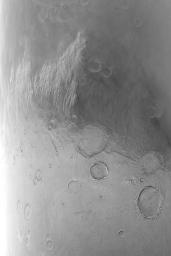
|
Noachis Dust Storm
- Click the image above for a larger view
- Full-Res JPEG (654 x 981) (58.5 kB)
- Full-Res TIFF (654 x 981) (616.6 kB)
Caption:
MGS MOC Release No. MOC2-523, 24 October 2003
The edges of the retreating seasonal polar caps of Mars are sites of frequent dust storms. The temperature contrast between the cold polar cap surfaces and the adjacent, warmer, frost-free surfaces set up the conditions for cold air to come streaming off the polar cap, picking up dust as soon as it hits the frost-free terrain. Dust storms are the result. This Mars Global Surveyor (MGS) Mars Orbiter Camera (MOC) image shows a dust storm in southeast Noachis Terra near 55°S, 316°W, on 21 June 2001. This was one of several precursor storms that led up to the global dust events of 2001. The frosted surface of the seasonal south polar cap is the lighter-toned terrain in the lower half of the image; the darker upper half is frost-free. Winds are blowing the dust storm (located at left-center) toward the north (top/upper right). The large crater just below the center of the picture is Peneus Patera. It is approximately 120 km (~75 mi) across. This MOC red wide angle picture is illuminated by sunlight from the upper left.
Cataloging Keywords:
| Name | Value | Additional Values |
|---|---|---|
| Target | Mars | |
| System | ||
| Target Type | Planet | |
| Mission | Mars Global Surveyor (MGS) | |
| Instrument Host | Mars Global Surveyor | |
| Host Type | Orbiter | |
| Instrument | Mars Orbiter Camera (MOC) | |
| Detector | ||
| Extra Keywords | Atmosphere, Crater, Dust, Grayscale, Storm | |
| Acquisition Date | ||
| Release Date | 2003-10-24 | |
| Date in Caption | 2001-06-21 | 2003-10-24 |
| Image Credit | NASA/JPL/Malin Space Science Systems | |
| Source | photojournal.jpl.nasa.gov/catalog/PIA04810 | |
| Identifier | PIA04810 | |
